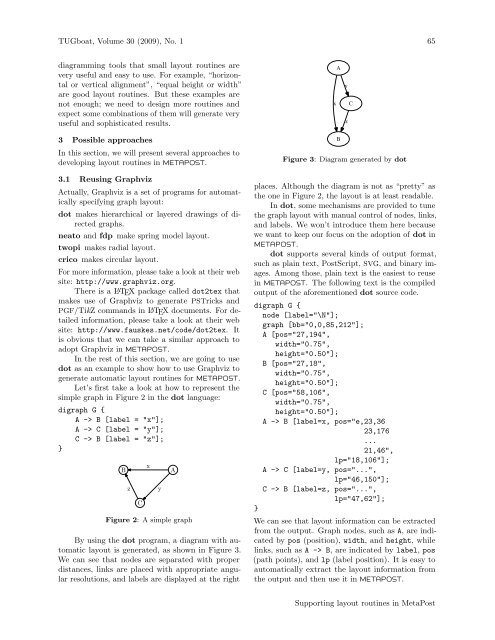Supporting layout routines in MetaPost - TUG
Supporting layout routines in MetaPost - TUG
Supporting layout routines in MetaPost - TUG
You also want an ePaper? Increase the reach of your titles
YUMPU automatically turns print PDFs into web optimized ePapers that Google loves.
<strong>TUG</strong>boat, Volume 30 (2009), No. 1 65<br />
diagramm<strong>in</strong>g tools that small <strong>layout</strong> <strong>rout<strong>in</strong>es</strong> are<br />
very useful and easy to use. For example, “horizontal<br />
or vertical alignment”, “equal height or width”<br />
are good <strong>layout</strong> <strong>rout<strong>in</strong>es</strong>. But these examples are<br />
not enough; we need to design more <strong>rout<strong>in</strong>es</strong> and<br />
expect some comb<strong>in</strong>ations of them will generate very<br />
useful and sophisticated results.<br />
x<br />
A<br />
y<br />
z<br />
C<br />
3 Possible approaches<br />
In this section, we will present several approaches to<br />
develop<strong>in</strong>g <strong>layout</strong> <strong>rout<strong>in</strong>es</strong> <strong>in</strong> METAPOST.<br />
3.1 Reus<strong>in</strong>g Graphviz<br />
Actually, Graphviz is a set of programs for automatically<br />
specify<strong>in</strong>g graph <strong>layout</strong>:<br />
dot makes hierarchical or layered draw<strong>in</strong>gs of directed<br />
graphs.<br />
neato and fdp make spr<strong>in</strong>g model <strong>layout</strong>.<br />
twopi makes radial <strong>layout</strong>.<br />
crico makes circular <strong>layout</strong>.<br />
For more <strong>in</strong>formation, please take a look at their web<br />
site: http://www.graphviz.org.<br />
There is a L A TEX package called dot2tex that<br />
makes use of Graphviz to generate PSTricks and<br />
PGF/TikZ commands <strong>in</strong> L A TEX documents. For detailed<br />
<strong>in</strong>formation, please take a look at their web<br />
site: http://www.fauskes.net/code/dot2tex. It<br />
is obvious that we can take a similar approach to<br />
adopt Graphviz <strong>in</strong> METAPOST.<br />
In the rest of this section, we are go<strong>in</strong>g to use<br />
dot as an example to show how to use Graphviz to<br />
generate automatic <strong>layout</strong> <strong>rout<strong>in</strong>es</strong> for METAPOST.<br />
Let’s first take a look at how to represent the<br />
simple graph <strong>in</strong> Figure 2 <strong>in</strong> the dot language:<br />
digraph G {<br />
A -> B [label = "x"];<br />
A -> C [label = "y"];<br />
C -> B [label = "z"];<br />
}<br />
B<br />
z<br />
C<br />
x<br />
y<br />
A<br />
Figure 2: A simple graph<br />
By us<strong>in</strong>g the dot program, a diagram with automatic<br />
<strong>layout</strong> is generated, as shown <strong>in</strong> Figure 3.<br />
We can see that nodes are separated with proper<br />
distances, l<strong>in</strong>ks are placed with appropriate angular<br />
resolutions, and labels are displayed at the right<br />
B<br />
Figure 3: Diagram generated by dot<br />
places. Although the diagram is not as “pretty” as<br />
the one <strong>in</strong> Figure 2, the <strong>layout</strong> is at least readable.<br />
In dot, some mechanisms are provided to tune<br />
the graph <strong>layout</strong> with manual control of nodes, l<strong>in</strong>ks,<br />
and labels. We won’t <strong>in</strong>troduce them here because<br />
we want to keep our focus on the adoption of dot <strong>in</strong><br />
METAPOST.<br />
dot supports several k<strong>in</strong>ds of output format,<br />
such as pla<strong>in</strong> text, PostScript, SVG, and b<strong>in</strong>ary images.<br />
Among those, pla<strong>in</strong> text is the easiest to reuse<br />
<strong>in</strong> METAPOST. The follow<strong>in</strong>g text is the compiled<br />
output of the aforementioned dot source code.<br />
digraph G {<br />
node [label="\N"];<br />
graph [bb="0,0,85,212"];<br />
A [pos="27,194",<br />
width="0.75",<br />
height="0.50"];<br />
B [pos="27,18",<br />
width="0.75",<br />
height="0.50"];<br />
C [pos="58,106",<br />
width="0.75",<br />
height="0.50"];<br />
A -> B [label=x, pos="e,23,36<br />
23,176<br />
...<br />
21,46",<br />
lp="18,106"];<br />
A -> C [label=y, pos="...",<br />
lp="46,150"];<br />
C -> B [label=z, pos="...",<br />
lp="47,62"];<br />
}<br />
We can see that <strong>layout</strong> <strong>in</strong>formation can be extracted<br />
from the output. Graph nodes, such as A, are <strong>in</strong>dicated<br />
by pos (position), width, and height, while<br />
l<strong>in</strong>ks, such as A -> B, are <strong>in</strong>dicated by label, pos<br />
(path po<strong>in</strong>ts), and lp (label position). It is easy to<br />
automatically extract the <strong>layout</strong> <strong>in</strong>formation from<br />
the output and then use it <strong>in</strong> METAPOST.<br />
<strong>Support<strong>in</strong>g</strong> <strong>layout</strong> <strong>rout<strong>in</strong>es</strong> <strong>in</strong> <strong>MetaPost</strong>

















